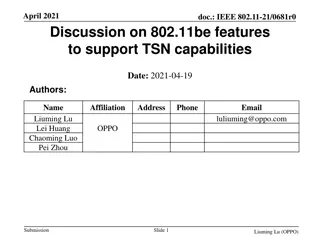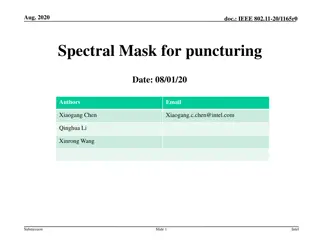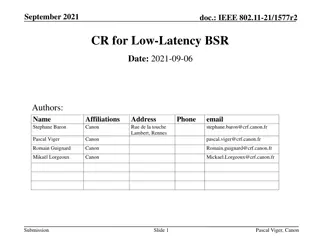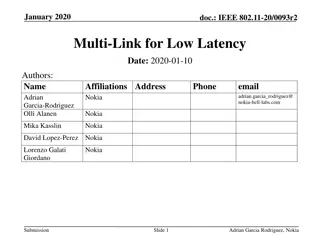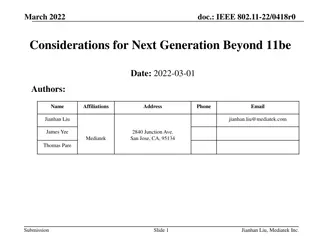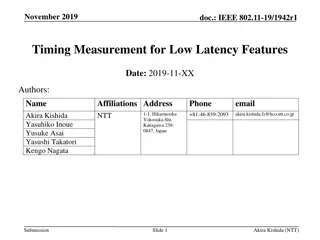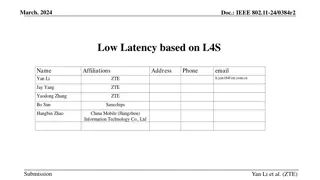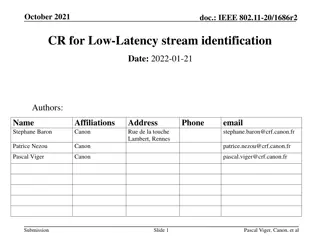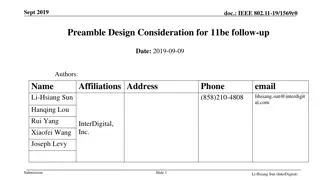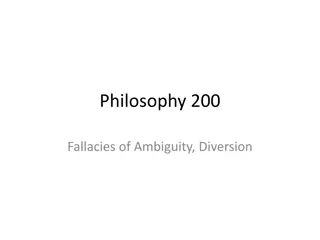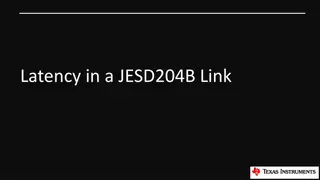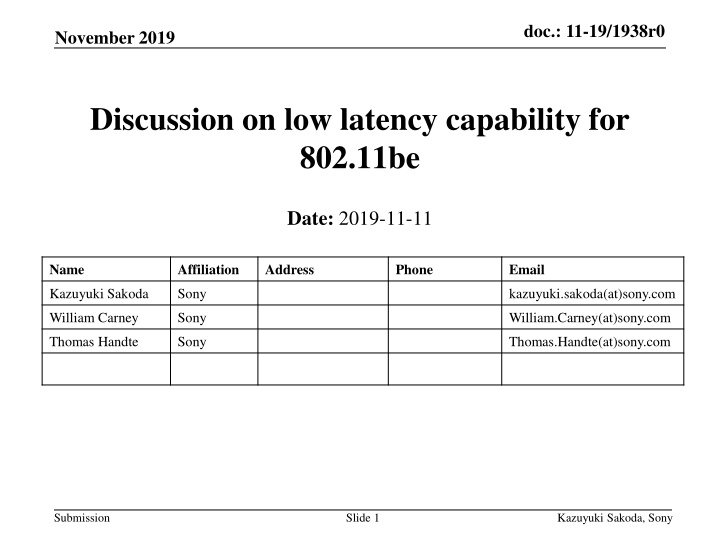
Discussion on Low Latency Capability for 802.11be
Explore the presentation by Kazuyuki Sakoda from Sony discussing the motivation behind reducing latency, target metrics, potential technologies, and real-time application use cases for 802.11be technology. Gain insights into latency definitions, end-to-end latency, and intra-BSS latency, aiming to improve communication for applications like mobile gaming, cloud gaming, and industrial systems.
Download Presentation

Please find below an Image/Link to download the presentation.
The content on the website is provided AS IS for your information and personal use only. It may not be sold, licensed, or shared on other websites without obtaining consent from the author. If you encounter any issues during the download, it is possible that the publisher has removed the file from their server.
You are allowed to download the files provided on this website for personal or commercial use, subject to the condition that they are used lawfully. All files are the property of their respective owners.
The content on the website is provided AS IS for your information and personal use only. It may not be sold, licensed, or shared on other websites without obtaining consent from the author.
E N D
Presentation Transcript
doc.: 11-19/1938r0 November 2019 Discussion on low latency capability for 802.11be Date: 2019-11-11 Name Affiliation Address Phone Email Kazuyuki Sakoda Sony kazuyuki.sakoda(at)sony.com William Carney Sony William.Carney(at)sony.com Thomas Handte Sony Thomas.Handte(at)sony.com Submission Slide 1 Kazuyuki Sakoda, Sony
doc.: 11-19/1938r0 November 2019 Agenda Recap on real-time application use case Target metric Potential technologies that 802.11be should consider Discussion and straw-poll Submission Slide 2 Kazuyuki Sakoda, Sony
doc.: 11-19/1938r0 November 2019 Motivation 802.11be is supposed to provide a technology to minimize worst- case latency and jitter [1] RTA TIG discussed use case, requirements, and potential technologies to mitigate the latency issue. Outcome of the discussion is summarized in [2] According to [2], there are wide spectrum of latency requirements, depending on applications At this point in time, it is still not clear what type of delay- constrained application we should aim at, and what type of technical approach we should take with 802.11be This presentation will walk through the application requirements and potential technical approach, trying to start building a common understanding on our goal Submission Slide 3 Kazuyuki Sakoda, Sony
doc.: 11-19/1938r0 November 2019 Recap on real-time application use case [2] identified 6 use cases that will enjoy low latency communication Real-time Mobile Gaming Wireless Console Gaming Cloud Gaming Realtime Video (Interactive Video) Drone Control Industrial Systems Submission Slide 4 Kazuyuki Sakoda, Sony
doc.: 11-19/1938r0 November 2019 Latency definition [2] End-to-End latency Intra-BSS latency Submission Slide 5 Kazuyuki Sakoda, Sony
doc.: 11-19/1938r0 November 2019 Latency definition [2] End-to-End latency: System level round trip time (RTT) among devices in a feedback loop system involving 802.11 link to transmit data between devices. End-to-End latency includes all factors that contribute to impact latency, including 802.11 link transmission delay, non-802.11 link transmission delay, signal processing delay, delay caused by synchronization, etc. For instance, in-game latency is one form of the End-End latency. Intra-BSS latency: Time consumed to transmit an MSDU from a STA to another STA within a BSS. It is equal to elapsed time while an MSDU travels from MAC-SAP of a transmitter STA to MAC-SAP of a receiver STA in a BSS. Submission Slide 6 Kazuyuki Sakoda, Sony
doc.: 11-19/1938r0 November 2019 Target metric Use cases Intra latency/ms < 5 < 10 BSS Jitter variance/ms < 2 < 2 Packet loss Data rate/ Mbps < 1 < 0.1 (Reverse link) > 5 (Forward link) 100 ~ 28,000 Real-time gaming Cloud gaming < 0.1 % Near-lossless Real-time video < 3 ~ 10 < 1~ 2.5 Near-lossless Robotics and industrial automation Equipment control < 1 ~ 10 < 0.2~2 Near-lossless < 1 Human safety Haptic technology < 1~ 10 <1~5 < 0.2 ~ 2 <0.2~2 Near-lossless Lossless < 1 <1 Drone control <100 <10 Lossless <1 >100 with video Requirements varies depending on the application Intra-BSS latency: 1msec : Motion control with safety constraints 5~ 10msec : Realtime video input/output ~ 100msec: Remote control Slide 7 Submission Kazuyuki Sakoda, Sony
doc.: 11-19/1938r0 November 2019 Potential technology that 802.11be should consider (1) TSN integration: As discussed intensively in [3], [4], [5], etc. Although the coverage of 802.11 is MAC/PHY in a BSS, the standard should define a set of interface that allows vendors to design a system meeting End-to-End latency requirements Making 802.11 MAC/ MLME interface compatible with TSN framework Time Synchronization, Bounded Latency, etc. CUC CNC End Device TSN Talker End Device TSN Listener TSN Switch Wired TSN Domain End Device End Device Wireless TSN Access Point Wireless TSN Domain CUC: Central User Configuration CNC: Central Network Configuration Submission Slide 8 Kazuyuki Sakoda, Sony
doc.: 11-19/1938r0 November 2019 Potential technology that 802.11be should consider (2) Technologies to minimize Intra-BSS latency [6] gives very helpful breakdown of the latency components in an BSS Let us walk through high-level category of the latency components EDCA DL OFDMA UL OFDMA Submission Slide 9 Kazuyuki Sakoda, Sony
doc.: 11-19/1938r0 November 2019 Potential technology that 802.11be should consider (3) Queuing and scheduling delay: After an RTA datagram passed MAC-SAP of a transmitter, the datagram is queued in a transmitter s queue If there are other traffic queued at the transmitter s queue, it may take some time until the STA will trigger transmission attempt of the RTA datagram Queueing delay If frame transmissions are made based on scheduling, the time until the RTA datagram is scheduled will be added as a part of the latency Scheduling delay As discussed, there should be ways to minimize queueing delay [7], [8], and scheduling delay [9], [10], [11] There should be many other approaches that could contribute to minimize these delays, depending on the assumption, target scenario and application Submission Slide 10 Kazuyuki Sakoda, Sony
doc.: 11-19/1938r0 November 2019 Potential technology that 802.11be should consider (4) Channel access delay: After a STA triggers transmission attempt (start counting backoff), the STA needs to perform CCA to gain access to the channel. There are many uncertainty in channel access owing to the nature of unlicensed spectrum However, there should be ways to minimize channel access delay as proposed in [11], [12], [13], [14] In addition to Intra-BSS channel access control, we should consider minimizing channel access delay even when OBSS signal is present Submission Slide 11 Kazuyuki Sakoda, Sony
doc.: 11-19/1938r0 November 2019 Potential technology that 802.11be should consider (5) Retransmission and ARQ: It is possible that a receiver cannot decode a transmitted frame correctly for variety of reasons 802.11 relies on retransmissions to gain reliability However, typical 802.11 retransmission will accumulate additional latency with another channel access delay It should be reasonable to revisit retransmission and ARQ scheme for low latency traffics [14], [15] Submission Slide 12 Kazuyuki Sakoda, Sony
doc.: 11-19/1938r0 November 2019 Discussion What type of application should 802.11be aim at in terms of latency/jitter requirements? Slides 4 and 7 Do we think low-latency discussion is making sense for now? Slides 8-12 Submission Slide 13 Kazuyuki Sakoda, Sony
doc.: 11-19/1938r0 November 2019 Strawpoll (1) What should be our intra-BSS latency target for real-time application? ~1 msec (Typical application: Motion control with safety constraints) 5~10 msec (Typical application: Gaming / Real time video) ~100msec (Typical application: Remote control) Submission Slide 14 Kazuyuki Sakoda, Sony
doc.: 11-19/1938r0 November 2019 Strawpoll (2) Should we consider queuing and scheduling delay mitigation techniques for real-time applications? Y N A Submission Slide 15 Kazuyuki Sakoda, Sony
doc.: 11-19/1938r0 November 2019 Strawpoll (3) Should we consider channel access delay mitigation techniques with OBSS scenario specifically for real-time applications? Y N A Submission Slide 16 Kazuyuki Sakoda, Sony
doc.: 11-19/1938r0 November 2019 Strawpoll (4) Should we consider retransmission/ARQ enhancement techniques for real-time applications? Y N A Submission Slide 17 Kazuyuki Sakoda, Sony
doc.: 11-19/1938r0 November 2019 References [1] 802.11-18/1231r6 EHC draft proposed PAR, Laurent Cariou [2] 802.11-18/2009r6 IEEE 802.11 Real Time Applications TIG Report, Kate Meng, et.al. [3] 802.11-19/1287r1 TSN support in 802.11 and potential extensions for TGbe , Dave Cavalcanti, et.al. [4] 802.11-19/1266r1 Wireless + TSN = Part of the Picture , Norman Finn [5] 802.11-19/1298r1, IEEE 802.1 TSN An Introduction , Janos Farkas [6] 802.11-19/762r1, Latency analysis for EHT, Suhwook Kim, et.al. [7] 802.11-19/1175r0, Considerations of New Queue Mechanism for Real- Time Application, Xin Zuo, et.al. [8] 802.11-19/1524r0, Latency enhancement for EHT, Suhwook Kim, et.al. [9] 802.11-19/1622r0, Use Auto Repetition in low latency queue, Tony Zeng, et.al. Submission Slide 18 Kazuyuki Sakoda, Sony
doc.: 11-19/1938r0 November 2019 References [10] 802.11-19/1538r1 Use of Uplink Persistent Allocation for RTA, Xin Zuo, et.al. [11] 802.11-19/1118r1, Enhancements for Time-Critical Data Transmission, Thomas Handte, et.al. [12] 802.11-19/1615r0, Multi-band/Multi-channel Operation for Low Latency and Jitter, Liuming Lu, et.al. [13] 802.11-19/1081r1, Multi-Link Aggregation: Latency Gains, Abhishek Patil, et.al. [14] 802.11-19/1223r0, Improving WLAN reliability, Antonio del la Oliva, et.al. [15] 802.11-19/1884r0, Discussion on RTA Retransmission, Liangxiao Xin, et.al. Submission Slide 19 Kazuyuki Sakoda, Sony

